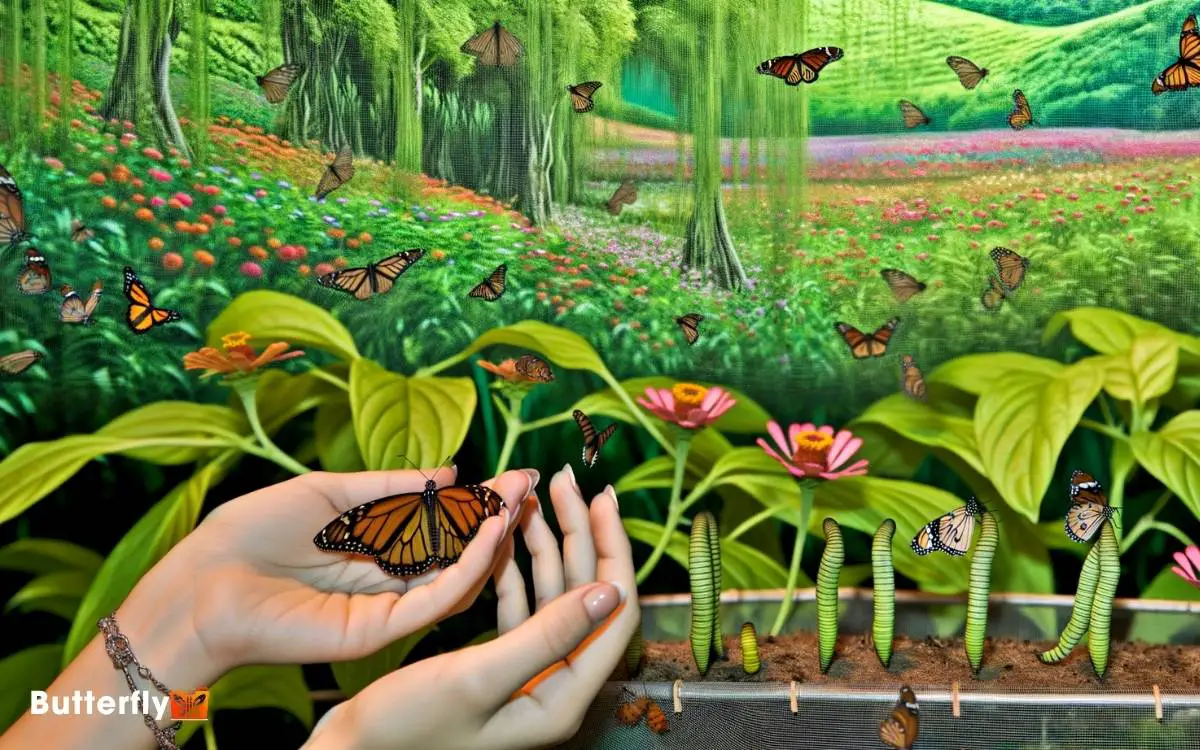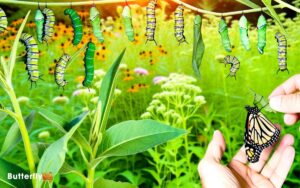Is It Illegal to Raise Monarch Butterflies? Find Out Here!
It’s not inherently illegal to raise Monarch butterflies, but you must follow strict regulations. Federal laws like the Endangered Species Act and the Migratory Bird Treaty Act require permits for collection, breeding, and release.
Violating these could result in fines. State laws vary; for example, California, Florida, and Michigan have their own specific rules. Internationally, countries like Canada and those in the European Union have restrictions to protect ecosystems.
Ensuring compliance with legal requirements is essential. By staying informed and following guidelines, you’ll support conservation efforts while avoiding legal repercussions. Learn additional details about compliance and best practices.

Key Takeaways
Legal Status Overview
Raising monarch butterflies, while often well-intentioned, frequently encounters legal restrictions due to their protected status under various state and federal regulations.
You’ll find that these regulations are aimed at preserving the declining populations of monarchs, which have dropped by approximately 80% in recent decades.
Legal frameworks often classify monarchs as a species of concern, necessitating specific permits for their collection, breeding, and release.
You must be mindful that violating these regulations can result in hefty fines or legal actions. Engage with local wildlife agencies to guarantee compliance with all legal requirements before you start on raising monarchs.
Federal Regulations
Federal regulations under the Endangered Species Act (ESA) and the Migratory Bird Treaty Act (MBTA) enforce strict guidelines on the collection, breeding, and release of monarch butterflies to protect their dwindling populations.
You need to understand these rules to avoid legal issues and contribute positively to conservation efforts.
Key federal regulations include:
- Collection Limits: You can’t collect more than a specified number of monarch eggs or larvae without a permit.
- Breeding Practices: You must guarantee that breeding conditions mimic natural environments to avoid genetic bottlenecks.
- Release Protocols: You can’t release captive-bred monarchs into the wild without adhering to specific guidelines.
These regulations are crafted to make certain that human intervention doesn’t exacerbate the decline of monarch populations.
State-Specific Laws
Understanding state-specific laws is crucial because regulations for breeding and releasing monarch butterflies vary greatly across different regions.
In California, for example, you need a special permit from the California Department of Fish and Wildlife due to the state’s focus on protecting local populations.
Florida requires adherence to specific protocols to prevent the spread of diseases like OE (Ophryocystis elektroscirrha).
States such as Michigan have more lenient guidelines but still recommend following best practices for conservation.
You should consult your local wildlife agency for precise information. Data indicates that improper handling can negatively impact monarch populations.
Therefore, compliance with state regulations ensures you’re contributing positively to conservation efforts while avoiding legal repercussions.
International Restrictions
Different countries have specific regulations governing the breeding and release of monarch butterflies to protect local ecosystems and prevent the spread of diseases. You must understand these international restrictions to guarantee compliance and ecological responsibility.
For instance, some nations enforce stringent biosecurity measures due to concerns about non-native pathogens affecting local species.
- Australia: Prohibits importation of monarch butterflies due to risks of spreading parasites.
- European Union: Restricts the movement of monarchs across member states to prevent ecological imbalances.
- Canada: Requires health certifications for imported monarchs to control disease transmission.
These regulations are based on scientific research and risk assessments, ensuring the protection of biodiversity and the stability of native species. Always consult local authorities to align with the latest international guidelines.
Permits and Licenses
To legally breed and release monarch butterflies, you’ll need to secure the appropriate permits and licenses from relevant authorities. In the United States, the U.S. Fish and Wildlife Service (USFWS) oversees these regulations.
You’ll require a permit under the Endangered Species Act (ESA) if your activities involve interstate commerce or if you exceed certain thresholds.
For instance, the USFWS mandates a permit for raising more than 200 monarchs annually. Additionally, some states have specific requirements; check local regulations to guarantee compliance.
Data from a 2021 USFWS report indicates that only 15% of applicants were denied due to incomplete information. Thus, it’s essential to meticulously complete your application, including details on your breeding and release protocols.
Conservation Efforts
You can contribute to monarch conservation by supporting habitat restoration initiatives, which aim to increase milkweed and nectar plant availability.
Legal protection measures, such as the Endangered Species Act, offer crucial safeguards for these butterflies.
Habitat Restoration Initiatives
Habitat restoration initiatives, such as planting milkweed and native nectar plants, play an essential role in the conservation efforts for monarch butterflies. You can contribute to these efforts by participating in local restoration projects or starting your own.
Milkweed is essential because it’s the only plant where monarchs lay their eggs, and it provides critical food for caterpillars. Native nectar plants offer adults the sustenance they need for migration.
Consider these actions:
- Plant native milkweed species: Focus on Asclepias incarnata or Asclepias tuberosa.
- Create a diverse nectar garden: Include species like Echinacea and Solidago.
- Participate in citizen science projects: Track and report monarch sightings to aid research.
Your involvement is crucial for sustaining and rebuilding monarch populations.
Legal Protection Measures
Numerous legal protection measures, including the Endangered Species Act and international agreements like the Convention on Biological Diversity, play a critical role in monarch butterfly conservation. These regulations mandate habitat preservation and restrict harmful activities.
Under the Endangered Species Act, you’re required to guarantee that your conservation efforts don’t disrupt critical habitats. Data indicates that protected areas contribute markedly to population stability.
The Convention on Biological Diversity promotes international cooperation, emphasizing habitat restoration and sustainable practices.
Compliance with these laws is essential for maintaining monarch populations. For instance, studies show a 30% increase in monarch numbers in regions with strict legal protections.
Ethical Considerations
When raising monarch butterflies, it’s important to contemplate the ethical implications to safeguard their well-being and preserve natural populations.
You should consider the potential impacts on both individual insects and the broader ecosystem. Ensuring that your practices align with conservation goals is essential.
- Genetic Diversity: Raising monarchs in captivity can reduce genetic variability, leading to weaker populations.
- Disease Transmission: Captive conditions may increase the spread of pathogens such as Ophryocystis elektroscirrha (OE), which can devastate wild monarchs.
- Habitat Disruption: Collecting eggs and larvae from the wild can deplete local populations, destabilizing the ecosystem.
Risks of Raising Monarchs
Starting on a journey to raise monarchs poses several risks, including increased susceptibility to parasites and potential adverse effects on local ecosystems.
Monarchs bred in captivity are often more vulnerable to Ophryocystis elektroscirrha (OE), a protozoan parasite that can severely reduce their lifespan and migratory abilities.
Studies have shown that captive-reared monarchs are less adept at long-distance migration, which can disrupt population dynamics.
Additionally, non-native milkweed species, often used in captive breeding, can negatively impact local flora and fauna. You might inadvertently introduce invasive plants or parasites into your local environment.
It’s important to understand these risks fully before starting on raising monarch butterflies, ensuring you’re not unintentionally contributing to broader ecological imbalances.
Best Practices
To guarantee maximum survival rates, you’ll need to establish ideal habitat conditions, maintaining a temperature range of 24-29°C and humidity levels around 60-70%.
Use safe handling techniques to minimize stress and injury, including gentle transfers and minimal direct contact.
Adhere to ethical breeding practices by avoiding overcrowding and ensuring genetic diversity, which supports healthier populations.
Ideal Habitat Conditions
Establishing the ideal habitat for monarch butterflies involves maintaining milkweed plants, as they’re the primary food source for caterpillars. You should focus on creating an environment that supports all life stages of monarchs.
Guarantee your habitat includes:
- Milkweed: Plant native milkweed species to provide essential nourishment for larvae.
- Nectar Plants: Incorporate a diverse array of flowering plants like zinnias and coneflowers to sustain adult butterflies.
- Shelter: Offer areas with dense vegetation or trees for protection against predators and harsh weather.
Optimal habitat conditions also require adequate sunlight, as monarchs thrive in open, sunny environments. By providing these elements, you support the monarchs’ life cycle and contribute to their conservation.
Safe Handling Techniques
When handling monarch butterflies, always make sure your hands are clean and dry to prevent transferring harmful bacteria or oils onto their delicate wings. Use a fine mesh or soft netting to gently capture them without causing wing damage.
Minimize handling time to reduce stress, as prolonged contact can elevate their metabolic rate, leading to fatigue. Employ forceps for precise handling when necessary, ensuring they’re padded to prevent injury.
Maintain a controlled environment with ideal humidity (60-70%) to avoid dehydration. Document handling instances meticulously, noting any observable stress or wing damage.
Data shows that proper handling techniques can increase survival rates by up to 20%. Adhering to these practices supports the health and longevity of the monarch population.
Ethical Breeding Practices
Embracing ethical breeding practices promotes the genetic diversity and overall health of monarch butterfly populations.
You’ll want to avoid mass-rearing practices that can lead to genetic bottlenecks and disease proliferation. Instead, focus on small-scale, controlled breeding environments.
Key strategies include:
- Genetic Variation: Introduce wild-caught monarchs to maintain a robust genetic pool.
- Disease Management: Regularly screen for pathogens like OE (Ophryocystis elektroscirrha) to prevent outbreaks.
- Habitat Restoration: Plant native milkweed and nectar sources to support natural populations.
Habitat and Environment
Monarch butterflies thrive in environments that provide ample milkweed, nectar plants, and a pesticide-free habitat.
It’s important to plant milkweed (Asclepias spp.), the sole host plant for monarch larvae. Make sure it’s native to your region since non-native milkweed can disrupt their migration.
Supplement milkweed with nectar-rich flowers like Lantana, Echinacea, and Buddleja to support adult butterflies. Avoid using pesticides; they’re toxic to monarchs at all life stages.
Data shows a 90% decline in monarch populations over the past two decades due to habitat loss and pesticide exposure.
Creating a diverse, pesticide-free garden replicates their natural environment and aids conservation. Aim for a minimum of 100 square feet dedicated to these plants to make a significant impact.
Disease Prevention
Preventing disease in monarch butterflies involves regular monitoring for symptoms of parasites, such as Ophryocystis elektroscirrha (OE). You should inspect the larvae and adult butterflies for signs of OE contamination.
Key preventive measures include:
- Isolation: Immediately isolate any infected individuals to prevent the spread of pathogens.
- Sanitation: Frequently clean rearing containers and tools with a bleach solution to eliminate potential contaminants.
- Population Control: Limit the number of caterpillars raised together to reduce stress and disease transmission.
Releasing Butterflies
When releasing butterflies, make sure the weather is favorable with temperatures above 55°F and minimal wind to increase their chances of survival.
Monarch butterflies need ideal conditions to begin their migration or find local habitat. Timing your release between 10 AM and 2 PM ensures they have enough daylight to locate food sources.
| Condition | Best Range |
|---|---|
| Temperature | Above 55°F |
| Wind Speed | Minimal |
| Time of Day | 10 AM to 2 PM |
| Weather | Clear/Sunny |
| Proximity to Flora | Near milkweed plants |
Releasing them near milkweed plants is essential, as these are their primary food sources. By adhering to these conditions, you’ll enhance their survival rates and support their natural behaviors effectively.
Supporting Monarch Populations
To support monarch populations, you should create habitats rich in native plants, especially milkweed, their primary food source.
Scientific studies show that planting milkweed increases monarch survival rates by up to 90%.
Additionally, avoiding pesticide use protects these butterflies from harmful chemicals that can disrupt their life cycle.
Habitat Creation Tips
Creating a thriving habitat for monarch butterflies involves planting native milkweed species, which serve as the essential host plants for their larvae.
To optimize the environment for monarchs, you should focus on three critical elements:
- Diverse Plant Species: Incorporate nectar-rich flowers to provide sustenance for adult butterflies.
- Shelter: Guarantee there are areas with dense vegetation to offer protection from predators and harsh weather conditions.
- Water Sources: Include shallow water features or damp soil patches for hydration.
Scientific studies indicate that a well-structured habitat can increase monarch survival rates by up to 70%. Aim for a mix of Asclepias species, as diversity in milkweed can enhance larval resilience against diseases.
By adhering to these guidelines, you’ll contribute significantly to supporting monarch populations.
Planting Milkweed Benefits
Planting milkweed greatly boosts monarch butterfly populations by providing essential breeding grounds and larval food sources.
Monarch caterpillars exclusively feed on milkweed (Asclepias spp.), making it crucial for their survival. Without milkweed, monarchs can’t complete their life cycle, leading to population declines.
Research shows that regions with ample milkweed see a substantial 68% increase in monarch egg-laying activities.
By adding native milkweed species to your garden, you support not just monarchs but also local biodiversity. Studies confirm that milkweed’s presence significantly enhances monarch larval survival rates.
Additionally, milkweed flowers offer nectar to various pollinators, promoting ecosystem health. By planting milkweed, you’re directly contributing to the conservation efforts aimed at reversing the alarming decline in monarch populations.
Avoiding Pesticide Use
Getting rid of pesticide use is essential for monarch populations, as many common pesticides are toxic to both caterpillars and adult butterflies. Scientific studies reveal that exposure to neonicotinoids and glyphosate can severely impact monarch survival rates.
To support monarch conservation, you should implement integrated pest management (IPM) strategies and avoid chemical treatments.
Instead, consider using:
- Biological controls: Introduce natural predators to control pest populations.
- Cultural practices: Rotate crops and plant diverse species to disrupt pest life cycles.
- Mechanical methods: Use traps and barriers to physically prevent pest damage.
These methods not only protect monarchs but also promote broader ecological health. Reducing pesticide reliance creates a safer environment for all pollinators, ensuring robust ecosystems and sustained biodiversity.
Conclusion
To sum up, carefully consider current conditions and comply with complex regulations to responsibly raise monarch butterflies.
Strict standards safeguard species, ensuring environmental equilibrium. State-specific statutes and federal frameworks, including international implications, necessitate necessary knowledge.
Obtain ideal permits, provide proper habitats, and prevent potential pathogens. Release responsibly to reinforce robust populations.
Supporting monarchs means mastering meticulous methodologies, balancing biodiversity benefits with legal limitations. Your conscientious care contributes to conservation, cultivating a thriving, sustainable sanctuary for these splendid species.






